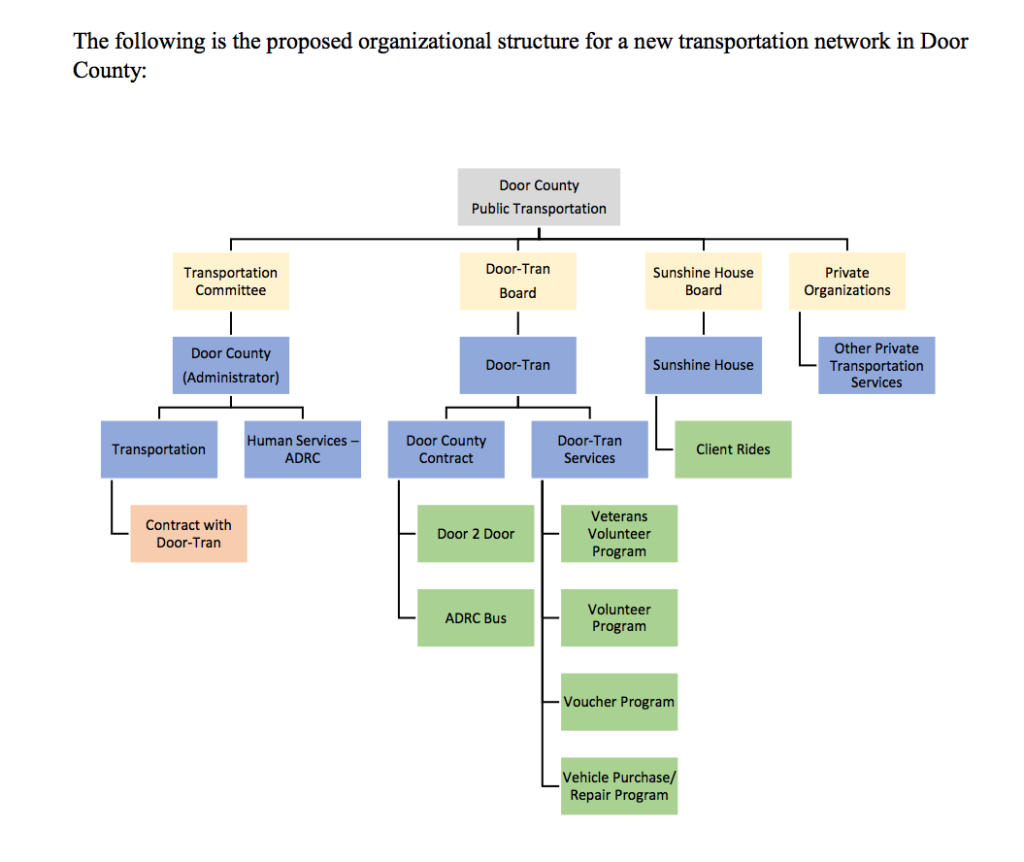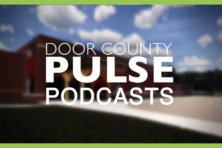County Wrestles with Issue of Providing Public Transportation
- Share
- Tweet
- Pin
- Share
Extra chairs had to be brought into the Door County Board meeting room Tuesday morning to accommodate all the people who wanted to hear discussion on the future of the Door 2 Door public-transportation system, and even then it ended up being standing room only.
The county announced in a press release the week before the meeting that projected costs to run the program are not sustainable, so many feared that it would be cut.
County Administrator Ken Pabich explained that the board would not reach a decision on the program during that meeting. Instead, those present would hear a presentation by Joe Krebsbach, who heads the county’s Human Services Department, which, by default, runs the public-transport program. Pabich said the board hopes to have a more solidified plan to present at the April county board meeting, and then a required public hearing will be held before any decisions are made.
Krebsbach gave a brief history of Door 2 Door, which began operating in 2010. He described it as a shared taxi service, although it differs from a traditional taxi service in that rides are not on demand. Instead, there are windows when they are available.
The service didn’t go much beyond Sturgeon Bay at first, but a Northern Door service was added in 2012. In 2015, all of Northern Door was connected, and Krebsbach said that according to the Wisconsin Department of Transportation, it was the fastest-growing public-transit system in the state. Two years ago, the final service expansion covered the entire county, and 2017 also represented the peak year for rides, at 44,000. The annual average is 42,600.
“The goal all along was to create a countywide program,” Krebsbach said.
He also provided ridership figures. Thirteen percent of riders are nondisabled and nonelderly adults who pay the full price of $3.50 per ride. Fifty percent are people with disabilities; 22 percent are people 60 and older; and 7 percent are students. All of these riders pay the half-price fare of $1.75. One other rider category – 6 percent – includes agencies that contract for the service, and they pay double the normal rate, or $7.
A whopping 82 percent of the ridership is in the core zone, Sturgeon Bay.
The county contracts with Abby Vans of Neilsville, Wisconsin, for the service at an hourly rate, which Krebsbach said is the most costly part of providing it. Door is just one of 34 Wisconsin counties that has a transportation contract with Abby Vans – which ends this year for Door County and will have to be rebid.
Financing for the services is a combination of state and federal funds and a county levy. Several financial factors have influenced the county’s decision to assess the Door 2 Door service, not the least of which came up last year when it was revealed that the Sunshine House transportation went from running at a deficit to breaking even, which negatively affects the state and federal money the county can apply for.

Wanting to take the service to the next level through efficiencies, Krebsbach said the county hired a consultant with the help of a grant written specifically for that purpose through Door Tran. The consultant identified the governance structure as a major impediment to growth, saying that a full-time transportation manager should be hired to manage the operation. Krebsbach acknowledged that though he is the titular head of the program, his other duties relegate Door 2 Door to a minor part of his work.
The consultant also recommended considering fixed routes, much like a traditional public bus service has; removing the Sunshine House as a partner because it no longer provides a mutual benefit; and seeking alternative funding sources. Another study of the system by Gwen Larson of Larson & Associates in Sturgeon Bay reached many of the same conclusions.
Pabich pointed out that public transportation is not a core function or service that the county must provide. Human Services does not have revenues to meet the shortfall for the service, and statutory levy limits mean funding cannot be sustained at the present level.
The county presented three options as potential solutions:
• Run the program in the manner the consultants suggested: hire someone to oversee the system, and somehow find the funding.
• Eliminate the system.
• Continue the system with greatly reduced hours.
The third option seemed to carry the most weight. The administration proposes reducing hours from 444 a week to 200, or 45 percent of the current service.The county projected that the average ridership of 42,000 would drop to 19,000 with the reduced hours.
“We’re looking for some direction,” Pabich said before opening the meeting to comments from supervisors and then the public.
Several supervisors voiced support for the public-transportation system and said they had already heard from constituents about its importance to some segments of the community.
Supervisor Bob Bultman asked about the most effective way for concerned citizens to get involved in the issue. Pabich said that although the program is under Kresbach, it would be more productive for citizens with questions to contact him instead.
That prompted Supervisor Susan Kohout to suggest the most important thing constituents could do is contact their legislators in Madison about the levy limits that all 72 counties in the state are struggling with.
“They could really help as citizens by saying to legislators, this doesn’t make any sense,” she said.
More than a dozen citizens spoke in support of Door 2 Door, including Amy Kohnle, executive director of the United Way of Door County. She talked about being part of a task force more than a dozen years ago that saw the need for public transport in the county. She also related a personal story about her own 82-year-old grandmother, who lived seven miles outside of Green Bay and had a “fiercely independent” life that kept her driving her own vehicle even though family members knew she should not be driving. But, with no public-transportation options and a busy social life, her grandmother continued to drive until she ran a stop sign. The accident killed her and seriously injured the driver of the other vehicle.
Sturgeon Bay resident Jon Wolfe said that two of his three adult children have severe mental-health issues and use Door 2 Door “pretty much on a daily basis.” Wolfe said he understands the current operation is not sustainable for the county but encouraged the reduced-hours option.
“Even if it’s less hours, it’s better than no hours at all,” he said.
Several speakers mentioned the need for the service among the elderly, including Marggie Hatala of Doulagivers of Door County. Working with the elderly, Hatala said she has for years advised people to live in an area where public transportation is available.
“It’s real critical for senior autonomy,” she said. “Please make sure this service continues.”
Sandy Brown, treasurer of the League of Women Voters of Door County, said the league supports continuing an affordable service so users can maintain an independent lifestyle and encouraged others to help the county find a solution.


